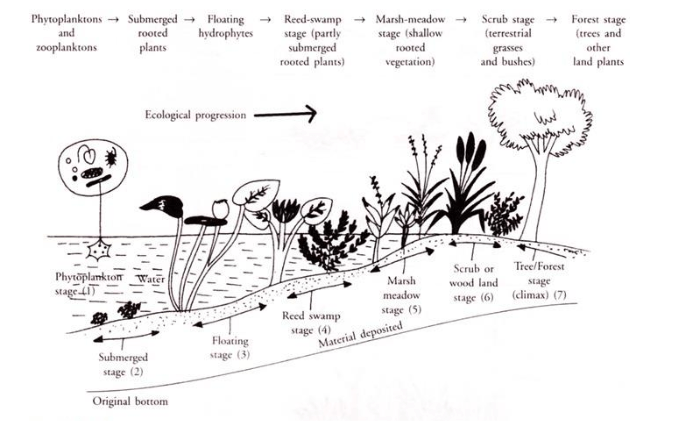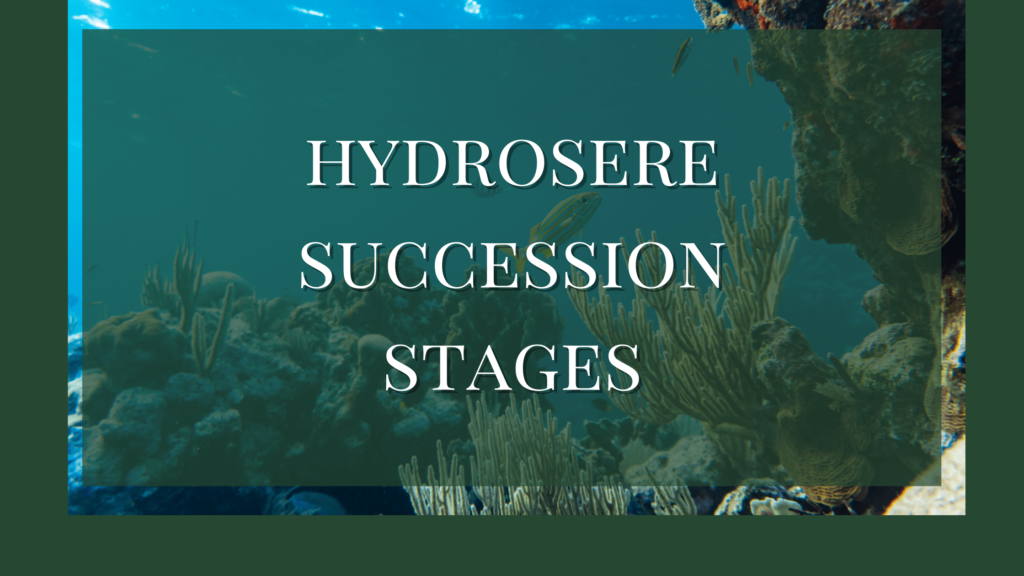Ecological succession happening in aquatic environments like lakes, ponds, rivers, marshes, etc., is called hydrarch succession and the various stages involved are termed hydrosere. The hydrosere succession stages need not change from an aquatic community into a land community in larger water bodies of considerable depth and strong waves or physical forces.
However, in a smaller aquatic community, there could be a transition starting from phytoplanktons that ends in a forest. It starts in the water deep in the middle, progressively moving towards the shallow areas, and ends up on the bank.
Hydrosere Succession Stages
The hydrosere succession stages that result in the development of climax communities may be described briefly as follows.
Phytoplankton Stage
The first step of this succession, the pioneer step involves phytoplanktons. They are unicellular colonial forms of green algae near the water surface, with no plant-like organisms at the bottom.
The initiation of hydrosere starts with algal spores that arrive with the water flow. The bacteria, algae, phytoplankton, and zooplankton are the pioneer colonizers. They add huge amounts of organic matter and nutrients through their activities.
Animals that feed on dead phytoplanktons are Amoeba, Paramecium, etc. Upon their death, the organic remains of the plants and animals mentioned above will fall to the bottom of the water body to form the muck layer.
Submerged Stage
The second stage of hydrosere succession is formed on the loose layer of muck at the bottom. It is seen in water where the depth is less than 20 ft or more than 10 ft. Here, the plants are completely submerged. Prominent submerged plants include pondweed, hydrilla, Vallisneria, Utricularia, Chara, and Ranunculus.
These are all rooted plants. When they die they sink to the bottom to form humus. This humus binds to soft muddy soil. They promote the deposition of soil particles at the bottom to make the water shallow over the period.
The subsequent deposition of organic matter of their dead remains along with soil particles raises the bottom to create a shallow water body. At this stage, the water becomes unsuitable for the submerged plants and more suitable for new invaders. Thus the next sere, the floating stage, starts.

Floating Stage
This stage is seen in water which has a depth of just 4-8 ft. Initially, the submerged plants are mixed with floating plants but gradually the former disappear and are completely replaced by floating plants.
This causes a change in the chemical and physical characteristics. The plants in this stage include Nymphaea, Nelumbum, Trapa, Lemma, Azolla, Pistia, etc.
These plants, through their interactions with each other and their environment gradually die and their decaying matter forms humus. Once again, this humus when combined with depositing soil particles reduces the depth of the water body. As the depth of the water reduces, it becomes unsuitable for these plants.
Moreover, as these plants form more and more humus, it contributes to the growing concentration of organic matter in the water. This also leads to the accumulation of salts making the water unsuitable for floating plants. Now, it is time for new types of plants to invade this place.
Reed Swamp Stage
The reed swamp stage of succession is seen in water with a depth of just 2-3 ft. The important plants that grow in this stage are Rumuex, Scripus, Sagittaria, etc. They are rooted at the bottom and just partially submerged. Their shoots extend above the water’s surface.
Gradually, these plants make the water more shallow by settling down the sedimentary material and deposition of humus. Consequently, this habitat becomes unsuitable for these plants making way for a new set of plants better adaptable to such conditions.
Marsh Meadow Stage or Sedge Meadow Stage
The shallow water body offers the substrate in marshy areas where the soil is covered by just a few inches, hardly 1-2 ft of water. It creates an environment more suitable for amphibian plants. The soil here may be fairly dry in summer. The habitat is suitable for tall grasses, Polygonum, mints, etc which form a meadow.
These plants transpire a great amount of water and deposit more sediments. Hydrophytes here find it difficult to grow which will be later replaced by plants of other stages.
Wet Woodland or Carr Stage
The wet woodland stage is an intermediate where the soil is still damp, but well drained. The soil type here can be mineral-rich, nutrient-poor, acidic, or alkaline. There will be no water-logging here.
The common vegetation found here are the trees such as willow, alder, and birches. Depending on the main vegetation, wet woodlands can be termed willow woods, birch woods, or alder woods.
These trees create a low, dense, or open canopy over some ferns, Sphagnum moss, meadowsweet, yellow flags, etc. The alders grow in the backwaters along the meanders of the water body. They grow taller and form support for great willowherb and nettles.
Woodland Stage
As the climate gets drier, the marshy plants lead to the formation of a grassland. But when the climate is moist, woodland is formed with several shrubs and small trees. This stage is characterized by plants that can tolerate water-locked soil around their roots. Eg. Salix, Cephalanthus, Populus, Tree-willows, etc.
These plants make the soil unsuitable for them by their activities and more suitable for shade-enduring herbs that grow among trees and shrubs.
Climax Stage or Climax Forest
As humus accumulates, soil microorganisms thrive and enrich the soil by degrading it. Now certain tall trees make their appearance under these shades. Sun-loving plants may not appear suddenly but they will gradually replace the shade-loving trees or plants.
Many shrubs and herbs of shade habitat grow under the trees. They assemble to form a climax forest, which is not subjected to further changes. Thus the area in which forest trees now occupy aquatic plants previously occupied.
This marks the end of the hydrosere succession stages. The entire process is progressive and extremely slow which is not distinctive. But the move of hydrosere from the water to land may be visible, especially in ponds and lakes that have shallower regions.
References
- Shukla, R.S. and Chandel, P.S. (2001) Plant Ecology. S. Chand and Company Ltd., New Delhi.
- Verma, P.S., Agarwal, V.K. (1999). Cell Biology Genetics Molecular Biology Evolution and Ecology. New Delhi: S.Chand Co.(Pvt) Ltd.
- Diagram of Hydrosere Succession Stages




